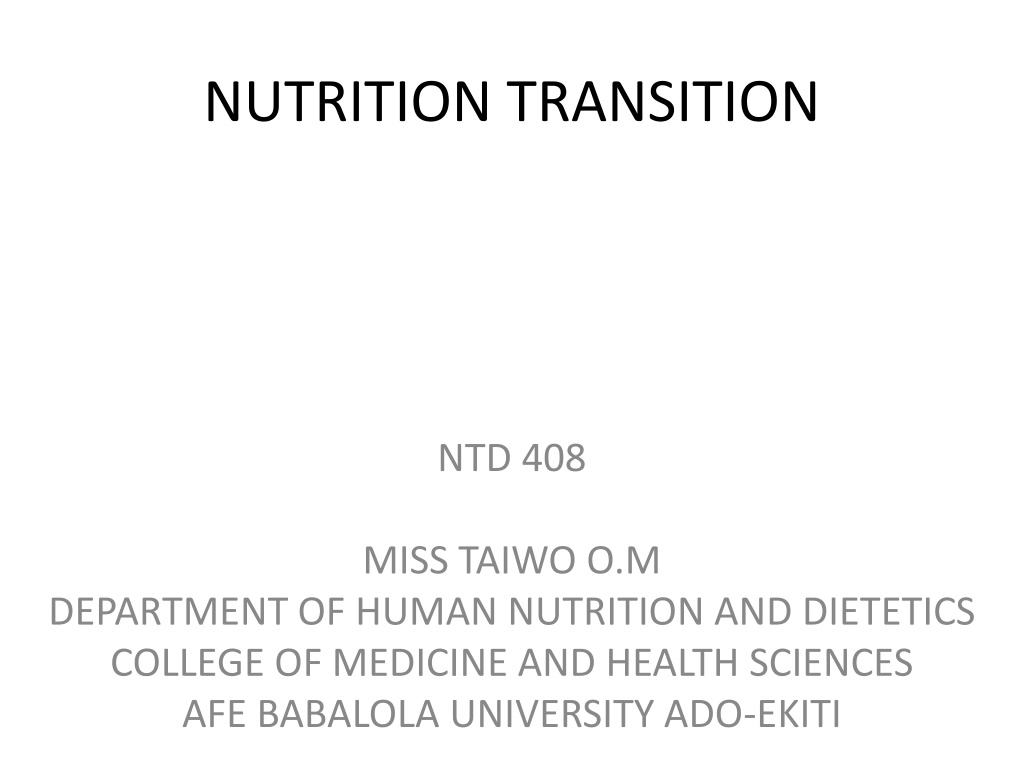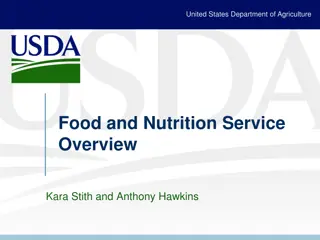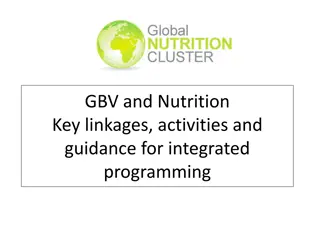Evolution of Nutrition Transition: Impact on Human Health
The Nutrition Transition discusses the shifts in diet patterns and physical activity levels over human history, leading to changes in body composition and health. It explores the stages of transition from hunter-gatherer lifestyles to modern diets, high in fat, salt, and sugar. This evolution has led to an increase in non-communicable diseases as societies move away from traditional diets towards processed foods.
Download Presentation

Please find below an Image/Link to download the presentation.
The content on the website is provided AS IS for your information and personal use only. It may not be sold, licensed, or shared on other websites without obtaining consent from the author. Download presentation by click this link. If you encounter any issues during the download, it is possible that the publisher has removed the file from their server.
E N D
Presentation Transcript
NUTRITION TRANSITION NTD 408 MISS TAIWO O.M DEPARTMENT OF HUMAN NUTRITION AND DIETETICS COLLEGE OF MEDICINE AND HEALTH SCIENCES AFE BABALOLA UNIVERSITY ADO-EKITI
TRANSITION PROCESSES During the last century, there has been wide- reaching changes in diet, nutritional status, disease patterns and life expectancy. These changes are thought to occur as separate THREE transition processes which are: 1. Demographic Transition 2. Epidemiological Transition 3. Nutrition Transition
Demographic Transition Epidemiologic Transition Nutrition Transition High fertility/ mortality High prevalence infectious disease High prevalence undernutrition Reduced mortality, changing age structure Receding pestilence, poor environmental conditions Receding famine Focus on family planning, infectious disease control Focus on famine alleviation/prevention Nutrition-related noncommunicable diseases predominate Reduced fertility, aging Chronic diseases predominate Focus on medical intervention, policy initiatives, behavioral change Focus on healthy aging spatial redistribution Source: Popkin (2002). Pub. Health Nutr 5.
THE NUTRITION TRANSITION Shifts in diet (western diet) and physical activity patterns and the effects on the body composition and health over the history of humans Characteristics Of Western Diet : high fat, low fiber, high salt, high content of simple carbohydrates (i.e. sugar It occurs in 5 stages
STAGES OF THE NUTRITION TRANSITION Hunter-Gatherer - Individuals live highly active lifestyles, hunting and foraging for food. Diets typically are low in fat (especially saturated fat), rich in fibrous plants and high in protein from lean wild animals. Low obesity levels . 1. 2. Famine - refers to a period of acute scarcity of food and little dietary variety. These changes are related to a shift towards settlements and the adoption of a lifestyle based on farming. At first, foods mainly consisted of crops, but later also included livestock and poultry. 3. Receding Famine - As farming developed, there was increased consumption of fruit and vegetables and less reliance on staple foods. The consumption of fruit, vegetables, and animal protein increased, while starchy staples become less important in the diet. Physical activity levels started to decrease.
4. Nutrition-related Non-communicable Disease This period is characterized by an increased availability of inexpensive, ultra- processed, energy-dense foods high in fat, cholesterol, and refined carbohydrates. This is also referred to as a Western diet. It is characterized by low levels of physical activity and high prevalence of obesity and obesity-related chronic diseases, such as diabetes and heart disease. . 5. Behavioural change - In response to increasing rates of obesity and obesity-related chronic diseases, individuals change their behavior and communities promote behavior changes to prevent these conditions. It occurs due to a desire to prolong health and delay or prevent degenerative diseases. The consumption of complex carbohydrates, fruit and vegetables increases, while the consumption of fat, processed foods, meat and dairy products are reduce. Increased level of physical activity.
STAGES OF THE NUTRITION TRANSITION Urbanization, economic growth, technological changes for work, leisure, & food processing, mass media growth Pattern 1 Paleolithic man/ Hunter-gathers Pattern 2 Pattern 3 Industrialization/ Receding Famine Pattern 4 Pattern 5 Desired societal/ Behavioral Change Settlements begin/ Monoculture period/ Famine emerges Noncommunicable Disease Reduced fat, increased fruit, veg, CHO, fiber Increase water, Reduce caloric beverage intake Replace sedentarianism w/ purposeful activity Starchy, low variety, low fat, high fiber water Labor-intensive work job/home Increased fat, sugar, processed foods caloric beverages Shift in technology of work and leisure Wild plants & animals water Labor intensive Cereals dominate water Labor-intensive Nutritional deficiencies emerge, stature declines Lean & robust, high disease rate MCH deficiencies, weaning disease, stunting Obesity emerges, range of other NR-NCD s Reduced body fatness, Reduced NR-NCD s High fertility, high MCH mortality, low life expectancy Low fertility, Low life expectancy Slow mortality decline Accelerated life expectancy, shift to increased DR-NCD, increased disability period Extended health aging, reduced DR-NCD Source: Popkin 2002 revised 2006.
At any given time, a country or region within a country may be at a different stage within this transition. While most high-income, developed countries seem to be in the final stage (stage 5) of the nutrition transition; developing countries have not been immune to this transition. Poor countries are plagued by the same risk factors (diets high in sugar, fat and alcohol, obesity, tobacco smoking and lack of physical activity) as their rich counterparts. Furthermore, rural and urban areas within the same country may be at different stages of the transition. Urban residents have access to a wider range of food products, many of which are high in fat and sugar. In addition, an increasing number of women are working, leaving less time for growing and producing food, shopping for ingredients, and preparing the often energy- intensive staples of traditional diets. Families therefore rely on processed foods, resulting in the development of obesity.
This is further exacerbated by the sedentary activities associated with urban jobs and the increase in the availability of televisions and computers. Sub-Saharan Africa (SSA), made up of low- and middle income countries, is undergoing a health transition causing these countries to experience a double burden of disease. The nutrition transition appears to be accelerating in SSA from the receding famine stage to the nutrition related non-communicable disease stage. As a result, an increasing number of households are experiencing the dual burden of underweight and obesity occurring simultaneously. At the same time high rates of NCDs, like diabetes, cardiovascular disease and cancer are occurring together with infectious diseases such as HIV/AIDS, tuberculosis and malaria.
Changed Dietary Pattern During Nutrition Transition Increased intake of high fat foods ( e.g. turkey parts, broiler chicken, animal entrails, fast foods etc.) Increased intake of refined carbohydrate foods (e.g. flour, noodles, pasta, etc.) Increased intake of salt and salty foods (e.g. flavor enhancers, some processed foods) Increased intake of simple sugars (e.g. carbonated and fizzy drinks) Reduced intake of high fibre foods (e.g. cassava tuber, green leafy vegetables)
FACTORS DRIVING NUTRITION TRANSITION Diet is sweeter & higher in animal fat, processed foods Activity patterns at work & home are shifting towards lower energy expenditure Lower food prices, modern technology and urbanization Globalization Governance























